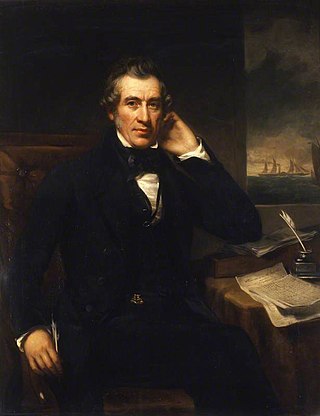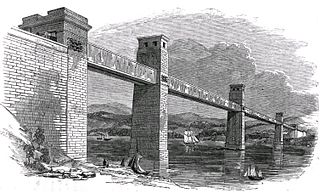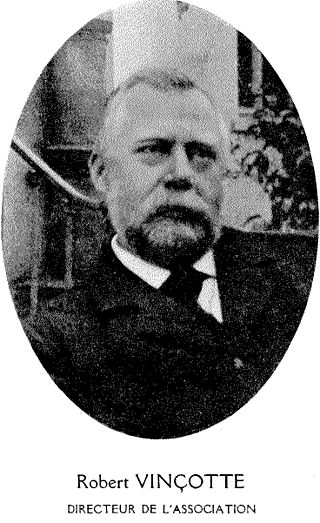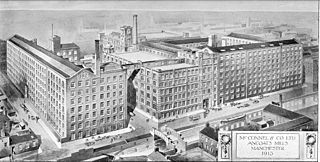Related Research Articles

A boiler is a closed vessel in which fluid is heated. The fluid does not necessarily boil. The heated or vaporized fluid exits the boiler for use in various processes or heating applications, including water heating, central heating, boiler-based power generation, cooking, and sanitation.

A safety valve is a valve that acts as a fail-safe. An example of safety valve is a pressure relief valve (PRV), which automatically releases a substance from a boiler, pressure vessel, or other system, when the pressure or temperature exceeds preset limits. Pilot-operated relief valves are a specialized type of pressure safety valve. A leak tight, lower cost, single emergency use option would be a rupture disk.

Sir William Fairbairn, 1st Baronet of Ardwick was a Scottish civil engineer, structural engineer and shipbuilder. In 1854 he succeeded George Stephenson and Robert Stephenson to become the third president of the Institution of Mechanical Engineers.
Eaton A. Hodgkinson FRS was an English engineer, a pioneer of the application of mathematics to problems of structural design.

A fire-tube boiler is a type of boiler in which hot gases pass from a fire through one or more tubes running through a sealed container of water. The heat of the gases is transferred through the walls of the tubes by thermal conduction, heating the water and ultimately creating steam.

A boiler explosion is a catastrophic failure of a boiler. There are two types of boiler explosions. One type is a failure of the pressure parts of the steam and water sides. There can be many different causes, such as failure of the safety valve, corrosion of critical parts of the boiler, or low water level. Corrosion along the edges of lap joints was a common cause of early boiler explosions.
William Fairbairn and Sons, was an engineering works in Manchester, England.

A fusible plug is a threaded cylinder of metal usually of bronze, brass or gunmetal, with a tapered hole drilled completely through its length. This hole is sealed with a metal of low melting point that flows away if a pre-determined, high temperature is reached. The initial use of the fusible plug was as a safety precaution against low water levels in steam engine boilers, but later applications extended its use to other closed vessels, such as air conditioning systems and tanks for transporting corrosive or liquefied petroleum gasses.

A box or tubular girder is a girder that forms an enclosed tube with multiple walls, as opposed to an I- or H-beam. Originally constructed of riveted wrought iron, they are now made of rolled or welded steel, aluminium extrusions or prestressed concrete.

A stationary engineer is a technically trained professional who operates, troubleshoots and oversees industrial machinery and equipment that provide and utilize energy in various forms.

Robert Vinçotte was a Belgian engineer who laid the basis for industrial workplace safety in his native country. He was involved in the founding of the two companies that would dominate the Belgian inspection and certification market during the twentieth century. He was also the brother of Thomas Vinçotte, a famous Belgian sculptor.

The Grover Shoe Factory disaster was an industrial explosion, building collapse and fire that killed 58 people and injured 150 when it leveled the R. B. Grover shoe factory in Brockton, Massachusetts on March 20, 1905. Following a boiler explosion, the four-story wooden building collapsed and the ruins burst into flames, incinerating workers trapped in the wreckage.

A Fairbairn crane is a type of crane of an 'improved design', patented in 1850 by Sir William Fairbairn. There are numerous hand-powered versions around the world and one surviving steam-powered example in Bristol Docks, England.

The Hartford Steam Boiler Inspection and Insurance Company (HSB) founded in 1866 and headquartered in Hartford, Connecticut, U.S., is a global specialty insurer and reinsurer. The company is the largest provider of equipment breakdown insurance and related inspection services in North America serving over five million commercial locations.

A shell or flued boiler is an early and relatively simple form of boiler used to make steam, usually for the purpose of driving a steam engine. The design marked a transitional stage in boiler development, between the early haystack boilers and the later multi-tube fire-tube boilers. A flued boiler is characterized by a large cylindrical boiler shell forming a tank of water, traversed by one or more large flues containing the furnace. These boilers appeared around the start of the 19th century and some forms remain in service today. Although mostly used for static steam plants, some were used in early steam vehicles, railway locomotives and ships.

McConnel & Kennedy Mills are a group of cotton mills on Redhill Street in Ancoats, Manchester, England. With the adjoining Murrays' Mills, they form a nationally important group.

W & J Galloway and Sons was a British manufacturer of steam engines and boilers based in Manchester, England. The firm was established in 1835 as a partnership of two brothers, William and John Galloway. The partnership expanded to encompass their sons and in 1889 it was restructured as a limited liability company. It ceased trading in 1932.

Boiler design is the process of designing boilers used for various purposes. The main function of a boiler is to heat water to generate steam. Steam produced in a boiler can be used for a variety of purposes including space heating, sterilisation, drying, humidification and power generation. The temperature or condition of steam required for these applications is different, so boiler designs vary accordingly.

The Fairbairn-Beeley boiler was a design of fire-tube stationary boiler developed in the late 19th century. It takes its name from its two developers, Sir William Fairbairn and Thomas Beeley
References
- ↑ Bartrip, Peter W. J. (April 1980). "The State and the Steam-Boiler in Nineteenth-Century Britain". International Review of Social History. 25 (1): 77–105. doi: 10.1017/S0020859000006222 .
- ↑ McEwen, Alan (2009). Historic steam boiler explosions. Keighley: Sledgehammer Engineering Press. ISBN 978-0-9532725-2-5.
- ↑ Fairbairn, William (1864). Useful Information for Engineers. London: Longman, Green, Longman, Roberts & Green.